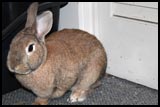Pet Articles
Hair Loss in Rabbits

There are four main causes for a rabbit suffering from hair loss, known as ‘alopecia’. These include ringworm, fur mites, behaviourally-induced hair loss and a disease called ‘sebaceous adenitis’.
You may have heard of ‘ringworm’ which is a disease that can affect different species including rabbits, dogs, cats and humans. It’s a condition primarily characterized by areas of hair loss. Ringworm is actually not a ‘worm’ at all. Ringworm is a type of fungus that grows within the outer layer of an animal’s skin and hair. The technical name for ringworm is ‘dermatophyte’. Dermatophytes are not very common in adult rabbits, they are more common in young rabbits due to an immature immune system. Clinical signs include crusting hair loss that can form lesions mostly on the head, legs, feet and nailbeds. This crusting may eventually become itchy, red, or full of pus if bacteria get into the wound. To diagnose this condition, hair and skin samples are tested. For the treatment of small lesions, the hair is clipped and a topical anti-fungal cream is applied. For extensive lesions, the entire coat is clipped. The rabbit is dipped in lime sulfur to kill the externally growing fungus, then given a full-body drug for 30 days. One must continue antifungals for 2 weeks beyond clinical resolution, thus treatment is long! This is due to the fact that the fungus not only can live in the skin and hair, but can also infect your pet’s entire body, and thus the drugs need to penetrate into the skin and bloodsteam to kill the fungus. Since this fungus can affect humans, make sure to wear gloves when handling animals with ringworm and wash your hands after handling them as well. You must also clean the environment and make sure the fungus is not growing anywhere else.
The fur mite Cheyletiella can also cause clinical signs of scaly, dry, sometimes itchy dermatitis (skin inflammation) with patchy bald spots over the neck, trunk, hind end and abdomen. To diagnose this, one uses these clinical signs plus the microscopic identification of mites via skin scrapings. It is important to note that mites can be hard to find, even on a scraping. So, how are these scrapings done? They are actually simple, very effective, and not painful for your rabbit! A small area of skin is gently scraped with a blade until loose pieces and chunks of dry skin peel off. If fur mites are found, treatment is three rounds of a drug called ivermectin given every two weeks.
Another cause of bald spots is barbering (which is behaviourally-induced). This happens when either a dominant rabbit pulls a subordinate’s hair, or this can be self induced if the rabbit is fed a low-fibre diet, or is in an overcrowded environment. The treatment includes separating dominant and subordinate rabbits, increasing fibre in the diet, or decreasing crowding, respectively.
The last common cause of hair loss in rabbits is sebaceous adenitis, which causes a non-itchy, scaly, flaky dermatitis that begins around the face and can be seen throughout the fur. Patchy alopecia can then follow. To diagnose this can be tricky, and all other causes need to be ruled out as this is a diagnosis of exclusion. The cause of sebaceous adenitis is unclear; so far no actual organisms, viruses or bacteria seem to be found in the lesions. It may be an immune mediated disease, where the rabbit’s immune system recognizes certain cells as invaders and attacks them. Unfortunately this disease is difficult to treat but new combination drugs are currently being developed.
